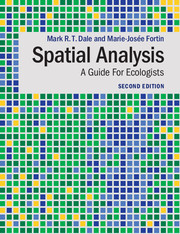Book contents
- Frontmatter
- Dedication
- Contents
- Preface
- 1 Spatial concepts and notions
- 2 Ecological and spatial processes
- 3 Points, lines and graphs
- 4 Spatial analysis of complete point location data
- 5 Contiguous units analysis
- 6 Spatial analysis of sample data
- 7 Spatial relationship and multiscale analysis
- 8 Spatial autocorrelation and inferential tests
- 9 Spatial partitioning: spatial clusters and boundary detection
- 10 Spatial diversity analysis
- 11 Spatio-temporal analysis
- 12 Closing comments and future directions
- References
- Index
12 - Closing comments and future directions
Published online by Cambridge University Press: 05 September 2014
- Frontmatter
- Dedication
- Contents
- Preface
- 1 Spatial concepts and notions
- 2 Ecological and spatial processes
- 3 Points, lines and graphs
- 4 Spatial analysis of complete point location data
- 5 Contiguous units analysis
- 6 Spatial analysis of sample data
- 7 Spatial relationship and multiscale analysis
- 8 Spatial autocorrelation and inferential tests
- 9 Spatial partitioning: spatial clusters and boundary detection
- 10 Spatial diversity analysis
- 11 Spatio-temporal analysis
- 12 Closing comments and future directions
- References
- Index
Summary
Introduction: myths, misunderstandings and challenges
It has become common for ecological studies to recognise the importance of the spatial aspects of ecological systems (e.g. Wagner & Fortin 2005; Schroeder & Seppelt 2006a; Hanski 2009; Leibold 2009; Fortin et al. 2012a; Gelfand 2012), and to include them in the design and analysis of these studies at least conceptually (Legendre et al. 2002, 2004). Spatial effects are various and many may act simultaneously or interdependently, including factors such as spatial scale, autocorrelation, locational and neighbour effects, functional connections, and the ubiquitous mutual interaction between spatial pattern and temporal processes. The set of topics in this constellation of ideas is complex and potentially confusing, especially when time is included as well as space. While the increasing awareness of the importance of spatial effects is helpful, the complexity has given rise to some misunderstandings and to a number of ‘myths’ about the issues and possible solutions. Although careful instruction and clear advice are available in the literature and in a number of textbooks (Cressie 1993; Legendre & Legendre 1998; Haining 2003; Fortin & Dale 2005; Schabenberger & Gotway 2005; Cressie & Wikle 2011), some challenges remain for researchers who face particular kinds of data and particular details of analysis. In this section we will make explicit a few of the prevalent myths about spatial effects, with an attempt to correct the related misunderstandings. Also we will acknowledge the real (not mythical at all!) challenges that including the spatial context presents for ecological studies.
When characterizing spatial pattern, several statistical and ecological concepts come into play and potential mismatches among them can occur in the appropriateness of their usage. Furthermore, a number of other considerations need to be acknowledged.
- Type
- Chapter
- Information
- Spatial AnalysisA Guide For Ecologists, pp. 361 - 397Publisher: Cambridge University PressPrint publication year: 2014



